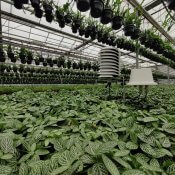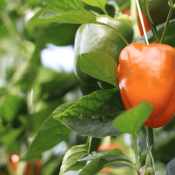5 digital horticulture practices to bring into 2020
In the past decade we’ve seen the world go through a major digital transformation. And it’s still going strong, with innovations piling up in all industries including the horticulture sector. We do believe there’s still a lot of untapped potential when it comes to digital horticulture. What happens when horticulture goes digital and where do you start? Let’s look at five digital horticulture practices you could bring into 2020.
1. Gain more control by measuring and comparing different variables

Accepting data from limited sources gives growers only a small picture of what’s happening in their greenhouse(s) or tunnel(s). In order for growers to move beyond control as a simple risk management strategy and use control as a profit driver, control devices have to become connected so all horticulture inputs can interact. That’s the purpose of our data platform.
Angela Zwinkels from Zwinkels Agro B.V., a Dutch eggplant grower: “With the climate computer and 30MHz sensors, we measure the greenhouse temperature, humidity levels, CO2 levels, solar radiation levels and plant temperatures, and we monitor this in 30MHz’s data platform. A big advantage of capturing and storing this data in one place is the ability to compare insights and analyze the relationships between different variables. For example, we measure the effect of the solar radiation on the plant temperature and compare plant temperatures with greenhouse/air temperature to prevent condensation, which causes mold. This becomes more important as the season progresses.”
“When we notice unfavorable changes in our crops or data, we can act on it straight away and know exactly what to do. Thanks to 30MHz’s data platform and sensors, it’s very easy to trace back and eventually predict when, where and why something is happening with our crops. We can check what the exact climate circumstances and settings were and make adjustments accordingly,” says Angela.
Another great example is pepper grower Gubbels. They’ve successfully been utilizing 30MHz technology to drive profits and increased pepper production by 2,5%. Their ROI is 256.4% within a year, and 813.5% within 3 years, with a payback period of a little over 3 months. “With better monitoring, we’re seeing way less scalded peppers. Based on the data in 30MHz’s data platform, I am able to keep windows closed longer, and by doing so am able to keep more humidity and CO2 in the glasshouse without the temperature getting too hot,” says Geert Colbers, crop manager at Gubbels. “By using the Pointed Microclimate sensor, we experience less pepper scald and more production since screens can be kept open longer. I used to play it safe more often before working with 30MHz technology, now I feel I can experiment more, like letting in more sunlight to optimize profit from the sun.”
The platform and sensor technology are also popular amongst researchers. Our partner Delphy uses 30MHz technology in their strawberry test center, where they work on ways to achieve optimal temperature and conserve energy via screening. They’re using the Pointed Microclimate sensor to monitor fruit temperature. Every week, they combine and compare this data to the other climate data, such as data from their climate computer, to perform in-depth analysis. Tristan Balk, Researcher Improvement Centre at Delphy, says: “The 30MHz platform is very user friendly and offers lots of freedom and flexibility to create customized dashboards that provide the insights we need to run our tests.”
Just like growing vegetables and fruit, there are a lot of variables that come into growing flowers as well. Dümmen Orange, a leading company in the breeding and development of cut flowers, potted plants, bedding plants and perennials, knows the benefits of measuring these different variables. They measure light, temperature, humidity, air pressure, EC and pot moisture. Mostly to allow the plants to grow healthily, keep them as vegetative as possible and prevent flowering induction.
>> Download the 30MHz Sensor Catalogue
2. Combine climate computer and sensor data in one platform

Data-based horticulture is becoming increasingly important. The real-time monitoring of a crop can optimize crop strategy. That’s why BASF chose to integrate their Priva climate computer with 30MHz’s data platform, together with a range of wireless climate sensors. Rob Wouters, crop specialist at BASF, says: “This setup provides better insight into our cultivation processes and gives us a platform that visualizes all the cultivation data in easy-to-read dashboards. The various measurements are now easily monitored and paint a clear picture of the climate throughout the greenhouse.”
BASF found that making this data available is not only beneficial for productivity, efficiency and resource management, it can also assist in the education of new employees. “One of our challenges is ensuring continuity of knowledge and transferring this knowledge to new employees,” says Rob. “Even for experienced professionals our process of internal training can take years. With 30MHz tech and the Priva integration we are able to explain our cultivation processes and transfer this knowledge to new colleagues more easily and quicker.”
Pepper grower Jacco van den Ende has successfully integrated his climate computer data into 30MHz’s platform, combining ambient statistics with crop level data. Jacco: “I can now easily combine and compare data in various graphs. For example, we’re able to spot and understand changes in temperature faster and more easily. Which means we can also act on it quicker. Before, I had to use and check two screens, sliding my chair from one desk to the next. Now I just need one screen and dashboard, which makes the job a lot simpler. The platform also serves as a great tool to communicate and collaborate with my crop consultant. We analyze the data to determine the ideal climate settings and find ways to improve productivity.”
Madestein UK also connected their Priva climate computer with the 30MHz platform last year. Director Jonathan Zwinkels: ‘We’ve experienced the integration of 30MHz’s platform and our Priva climate computer to be fairly low effort on our part. It was quick, efficient and remote. Bringing these data sources together has proved to be very beneficial. We’re able to cross-reference data (ex: VPD of basil leaf, or stress points on lettuce). We can graph the VPD data we get through 30MHz’s platform and understand it in the context of climate control, or ventilation positions. We can dig into the relationships between them, see the effects, and understand what needs to be changed to achieve our desired outcomes.”
3. Harness online data to protect crops from pests and diseases

Quality data is crucial when crafting an integrated pest management (IPM) programme, according to Ant Surrage, Technical Development Specialist at Fargro. He wrote about it in a contributed article of The Grower, a magazine by AHDB, last year. “Growers must recognize that it is likely their environment is not uniform. Hotspots, areas of high humidity and areas of damp will be key areas for pest and disease establishment. This should inform monitoring and preventative programmes, which will have knock-on effects on other elements of an IPM programme,” says Ant.
Growers can combine different metrics on environment and crop-level insights (including dew point, vapour pressure deficit/VPD, absolute humidity/AH, humidity deficit and the absolute difference between air temperature and dewpoint) in the 30MHz data platform. This provides the detailed overview needed to fight the range of insects, fungi and diseases that can compromise crop development.
Ant states: “For even greater detail, growers can monitor and understand the microclimate. The microclimate refers to the environment around a plant, this is often significantly different to the environment we feel when walking through the crop. It is necessary to understand the microclimate.”
But what happens when a virus breaks out? Viruses generally tend to spread easily and rapidly through handling, cutting and insect pollination, so prevention requires strict and proactive measures. Identifying viruses can be tricky. Digital and collaborative identification, with the ability to compare and comment on images in real-time without the need for on-site visits can make a huge difference in preventing further outbreak.
4. Make crop cultivation more data-driven

“In the horticulture sector, most growers cultivate their crops based on feeling and intuition. We are used to doing this as well. But now that the data tools and sensor technologies are getting better and better, we can start relying on data more and take a more data-driven approach. I think combining a growers’ intuition with the right data tools, such as crop level sensors, monitoring tools, analysis tools and system integrations, will become increasingly important,” says Matthijs Woestenburg, Innovation Manager at Gitzels Plant Nursery.
With the right tools, growers can create a database filled with meaningful and adequate data describing the status of climate and crop. They will be able to control and optimize growth plans and production processes in one digital platform. Growers can keep track of the crops in their greenhouse or tunnel in real-time, and keep an interactive record of their growing practices. Monitoring and analyzing information about, among other things, climate, soil moisture, energy use, CO2 and crop health at any time and place. This enables growers to make more data-driven decisions to optimize growing conditions, for example by adjusting climate, irrigation and pest management strategies. Leading to higher productivity, greater resource efficiency and better crop quality.
Matthijs: “We decided we wanted to take the next step in digitizing our production processes with 30MHz. Next to the platform, we started using microclimate sensors to compare that data with our existing climate computer data. This has given us many new, interesting insights. We’re also using the Sendot oxygen sensor, with which we can easily measure oxygen inside the pot and directly in the barrels. All this data is fed into 30MHz’s data platform, so that we can analyze and use those insights at any time of the day. With these new insights we are able to create a drier climate in the greenhouse, which means we can avoid downy mildew. By measuring oxygen levels and temperatures at crop level, it becomes a lot easier to optimize the climate for the plants. When the climate is optimal, the plant is healthy and doesn’t get sick. 30MHz’s platform provides the advantage of collecting all data in one place and making it accessible through multiple devices, including my phone.”
5. Collaborate across multiple locations for greater consistency

To serve the horticultural sector well, a data platform needs to make comparing locations easy – whether those locations are down the road, across the country, or across the globe.
The 30MHz data platform is built for collaboration around data. That means making it easy to work with a variety of data sources (sensor data, climate control, manual data input) and making it simple and intuitive to discuss and explore that data with colleagues, wherever they might be. The ability to engage, together, on real-time and historical crop data remotely is a major boost for horticulture businesses aiming for greater consistency across locations, for making the most of consultants’ expertise, and for leveraging knowledge within decentralized teams.
Piñata Farms in Australia has been successfully using our data platform’s collaboration features to streamline the exchange of information with UK-based berry growers. There are currently five growers who are using the platform, including Technical Manager Lee Peterson. “Through the data platform’s collaboration features, we can share dashboards and create groups with the growers at BerryWorld in the UK. This allows easy comparisons and contrasting of the various berry varieties across locations, and enables us to create comments and ask questions in the dashboard, streamlining the exchange of information.”


30MHz is typing… Our extended support team is ready to chat!
At 30MHz we think it’s important that our users can use our platform in an optimal way. At times you may have questions and you would like some help from our support team. Email and our support page filled with helpful articles were your go to’s. But we thought it was time for something extra… ...Read more
New 30MHz connect casing: How we protect your tech
To make sure your dataflow is fully protected, 30MHz introduces a new connect casing: waterproof, dust proof and even resistant to hits. This special shield will last longer and ensure a reliable dataflow from the connected sensor. What does that full protection mean? That’s what we will explain in this article. Watertight: resistant to wetness ...Read more
Smart assistant at work
After the launch of the smart (AI) assistant at GreenTech, the first growers have started using this new feature. The assistant helps them gain insights from their data faster and supports daily decision-making in the greenhouse. Growers report that they use the assistant for: Calculating differences in water content throughout the day Quickly identifying trends ...Read more


